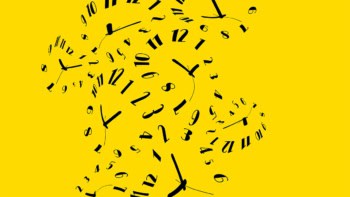This month Physics World introduces “Critical Point”, a regular series of articles by the historian of science Robert P Crease that will offer an outsider’s insights into the culture and practice of physics in the broadest sense. In his first article, Crease outlines the role of “science critics” and explains why they are an essential part of science

George Steiner once proposed a challenging thought experiment. He suggested that we imagine a world without art critics. What would it be like, asked Steiner, professor of English and comparative literature at the University of Geneva, if artists were supported and encouraged, while all art critics, commentators and interpreters were banned from the media and the academic world? What would it be like if, but for explicative and historically contextualizing commentary, “all talk about the arts, music and literature [were] prohibited [and] held to be illicit verbiage”?
The result, according to Steiner, would be a “primary city” of purely creative people, as opposed to the “secondary city” in which we now live, dominated by the derivative and domesticated interpreters of – and commentators on – creativity. Would society and the arts flourish in such a “counter-Platonic republic”, Steiner demanded to know, or would they wither and die?
Steiner, like Plato before him, recognized the impossibility of his ideal state, yet at the same time felt an intensely passionate longing for it. That longing for a world without critics sprang from Steiner’s sense that the contemporary mountain of commentary, paraphrase and secondary literature placed such a heavy burden on artists that it was in danger of smothering and choking off the creative imagination. “The tree dies under the hungry weight of the vines,” he complained.
A world without science critics
It is irresistible to propose the same thought experiment with respect to science. What if all science critics, commentators and interpreters simply disappeared? These would include the popularizers, who translate the special knowledge of science into ordinary language via images, clever use of language and other techniques. The popularizers are made up of a spectrum of people, from scientists who write sometimes brilliant books that are easily accessible to the public, via magazines like Physics World, all the way to non-scientists who write for magazines like Discover and the science sections of newspapers.
Another category of people who would disappear in a world without science critics would be the academic commentators. These are the people who examine the connections between scientific and other kinds of knowledge, but who to outsiders may sometimes end up appearing to reduce science to these other types of knowledge via ideological straitjackets, and who sometimes appear to undermine scientific knowledge by exposing its limitations. In this category I include many sociologists, philosophers and historians of science, including myself.
Meanwhile, there are the activists, who wield powerful images in pursuing their attacks on scientific facilities and programmes. One thinks of the anti-nuclear activities of groups like Greenpeace, or the recent protests of groups opposed to genetic engineering. The raw effectiveness of such action recently provoked one American senator to remark in the wake of the riots in Seattle against the World Trade Organisation that “the scientific debate is not being controlled by PhDs but apparently by young people with a proclivity for street theatre…It’s coming to the point that scientists are going to have to get dressed up as corncobs to get the attention of the media”.
What if these groups were all banned? What if there were only scientists and consumers or clients of scientific information – and no intermediary commentary or interpretation? Surely many professional scientists, feeling “the hungry weight of the vines”, would find the scenario appealing?
The case for critics
Of course, society does need appropriately trained legislators to keep in check people like Richard Seed, the physicist who announced that he was planning to open a human-cloning clinic. Some translators would also certainly be needed to keep those legislators informed, and to advise the politicians who fund the scientists. Nevertheless, would science or society really suffer if all the other popularizers, commentators and activists simply vanished?
At least two individuals – the political scientist Langdon Winner and the philosopher Don Ihde – have, in effect, championed the benefit of having critics. In the arts, Winner points out, critics are immediately understood as playing “a valuable, well established role, serving as a bridge between artists and audiences”. A critic of literature, for instance, “examines a text, analysing its features, evaluating its qualities, seeking a deeper appreciation that might be useful to other readers of the same text”. Unfortunately, Winner lamented, the same kind of function is not performed in the sciences, partly because scientists tend to regard as suspect anyone who plays the role of critic – as if science critics are by definition objecting to science or insisting on its limitations.
My colleague Don Ihde, meanwhile, actively calls for science critics and even outlines what he thinks they should be like. “The science critic would have to be a well informed – indeed [a] much better than simply well informed – amateur, in [the sense of] a ‘lover’ of the subject matter, and yet not the total insider.” The reason why the science critic must not be a total insider – just as an arts critic should not be a practising artist or literary author – is because, as Ihde puts it, “we are probably worst at our own self-criticism”.
Science critics, according to Winner and Ihde, would have an essential function. They would be there to assess the impact of science and technology on our political world (Winner) and on the human experience (Ihde). So, for example, Winner writes about the “politics” of technological artefacts, such as the way bridges over a Long Island motorway were built to exclude the buses that would carry lower-class citizens to the beach.
Ihde, meanwhile, writes about the transformation of experience by instruments. The dental pick, for instance, mediates and transforms the human sense of touch, enhancing the awareness of the texture of the surface of a tooth, while dampening awareness of properties like the tooth’s temperature. The pick allows dentists to feel cracks and soft spots more clearly than they could with their own fingers, albeit at the cost of losing certain (inessential) information. Ihde’s other examples include how fountain pens, typewriters and computers have affected the process of writing and how imaging technologies, such as those often used in physics, produce knowledge by transforming the information that has been imaged.
The kind of criticism advocated and practised by Winner and Ihde, in short, judges the presence of science and technology in society. But it seems to me that there is another, complementary model for science criticism. This model would focus on the way science is a profoundly social institution, with its own, ever-changing network of attitudes, values, practices, institutions, politics and even emotional responses. This network has certain affiliations with the cultural network of everyday life; scientists have distinctive ways, for example, of being rivals with one another, of celebrating discoveries, of conducting rituals like dedicating new machines, and so forth – all of which resemble ordinary strategies, processes and actions but with certain differences. The kind of science criticism I have in mind would examine and explore these differences. Instead of evaluating the presence of science in society, my kind of criticism would evaluate the presence of society in science.
The critical point
All of this brings us back to Steiner’s thought experiment: what would such critics ultimately contribute? The answer is linked to the fact that the two “cities” ultimately cannot be separated: the activities of the primary city – the artists and scientists themselves – take place in and are supported by the secondary city. It is easy for the first city to take the second for granted – and easy to assume that the equilibrium condition is that the primary city operates relatively freely and independently of the secondary one.
But this, of course, is fiction. The two cities are closely connected with each other. And the role of science critics, as I see them, would be to examine the intertwining of the two cities and clarify their value to each other. The activities of the primary city, for instance, would not appear to be lifeless, abstract, remote and therefore potentially threatening to the secondary city. In a similar way, art criticism does not aim simply to help the layperson understand a particular work of art, but ultimately to clarify the value of artistic production itself and therefore why it is worth supporting. The same could work for science.
What the thought experiment forces us to do, therefore, is to reverse the priority of the two cities – to see that the first city thrives on the second. Science, in other words, thrives on the presence of science critics. And the value of science criticism would be to help maintain the health of the “secondary” city that thrives on a well functioning “first”.



